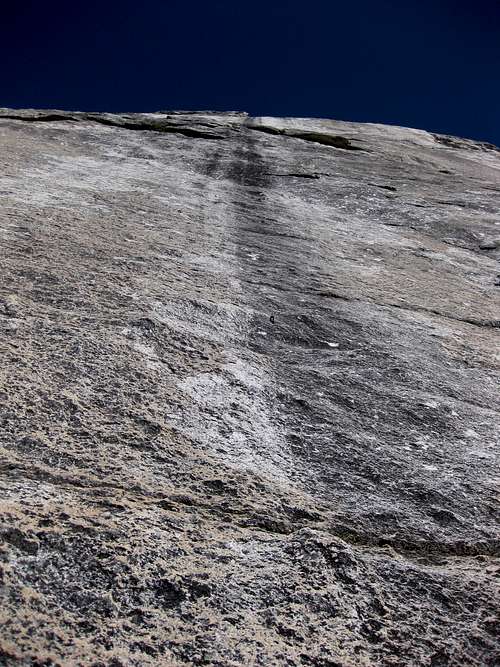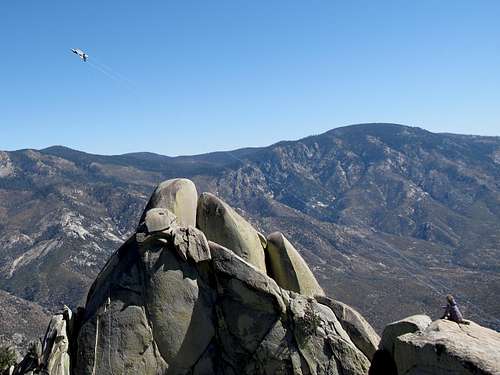So I plotted the vertical ascent rate vs grade.
What do you think happens when the grade gets close to 100%, and you're scrambling up?
Vertical Ascent Rate
Tips, tricks, workouts, injury advice.
-

Ze - Posts: 336
- Joined: Tue Oct 21, 2008 2:50 am
- Thanked: 61 times in 33 posts
Vertical Ascent Rate
by Ze » Fri Feb 26, 2010 6:54 pm
-

graham - Posts: 477
- Joined: Mon Aug 15, 2005 9:51 pm
- Thanked: 10 times in 8 posts
by graham » Fri Feb 26, 2010 8:19 pm
Your graph shows that you are really motoring up Big Iron at ~1 ft/sec; which works out to ~3600 ft/hour. Your uphill speed is impressive considering the Mt Baldy Run To the Top record is just a little over 1 hour and gets up about 4000 ft (ascending at ~4000 ft/hour).

Obviously, speed on steeper terrain drops off, but still incredibly impressive. The current El Cap (~3000 ft) speed climbing record by Hans Florine and Yuji Hirayama is around 2 hours, 37 minutes. So this world class performance on a ~3000% grade works out to about 1150 ft/hour.
Great stuff
The speed on a 100% grade (a 45 degree slope) would be highly “terrain” depended. For example, The Empire State Building Run-Up goes up 1,050 feet (at a grade approaching 100%) and the record is just under 10 minutes (ascending at ~6300ft/hour).Ze wrote:…. What do you think happens when the grade gets close to 100%, and you're scrambling up?
Obviously, speed on steeper terrain drops off, but still incredibly impressive. The current El Cap (~3000 ft) speed climbing record by Hans Florine and Yuji Hirayama is around 2 hours, 37 minutes. So this world class performance on a ~3000% grade works out to about 1150 ft/hour.
Great stuff
-

Ze - Posts: 336
- Joined: Tue Oct 21, 2008 2:50 am
- Thanked: 61 times in 33 posts
by Ze » Sat Feb 27, 2010 5:20 am
graham wrote:Your graph shows that you are really motoring up Big Iron at ~1 ft/sec; which works out to ~3600 ft/hour. Your uphill speed is impressive considering the Mt Baldy Run To the Top record is just a little over 1 hour and gets up about 4000 ft (ascending at ~4000 ft/hour).The speed on a 100% grade (a 45 degree slope) would be highly “terrain” depended. For example, The Empire State Building Run-Up goes up 1,050 feet (at a grade approaching 100%) and the record is just under 10 minutes (ascending at ~6300ft/hour).Ze wrote:…. What do you think happens when the grade gets close to 100%, and you're scrambling up?
Obviously, speed on steeper terrain drops off, but still incredibly impressive. The current El Cap (~3000 ft) speed climbing record by Hans Florine and Yuji Hirayama is around 2 hours, 37 minutes. So this world class performance on a ~3000% grade works out to about 1150 ft/hour.
Great stuff
thanks. I'd prefer to have generic data, but the only stuff I got that has any "control" in it is my own. As for the baldy race, well I think that fits in well with this discussion. Sure it is 4000 ft gain, but being almost 8 miles long there is a significant distance aspect that also takes up energy and time. when I include the trailrunning in the VAR, you would still see low VAR numbers at 10% grade, which the much of the race is at, when running at constant energy output. I did that race in 90 min. Whereas if it was 4000 ft up a 30% grade, Probably could cut off 20 mins.
-

Day Hiker - Posts: 3156
- Joined: Fri Dec 26, 2003 2:57 am
- Thanked: 61 times in 43 posts
by Day Hiker » Sat Feb 27, 2010 8:43 am
Ze wrote:graham wrote:Your graph shows that you are really motoring up Big Iron at ~1 ft/sec; which works out to ~3600 ft/hour. Your uphill speed is impressive considering the Mt Baldy Run To the Top record is just a little over 1 hour and gets up about 4000 ft (ascending at ~4000 ft/hour).The speed on a 100% grade (a 45 degree slope) would be highly “terrain” depended. For example, The Empire State Building Run-Up goes up 1,050 feet (at a grade approaching 100%) and the record is just under 10 minutes (ascending at ~6300ft/hour).Ze wrote:…. What do you think happens when the grade gets close to 100%, and you're scrambling up?
Obviously, speed on steeper terrain drops off, but still incredibly impressive. The current El Cap (~3000 ft) speed climbing record by Hans Florine and Yuji Hirayama is around 2 hours, 37 minutes. So this world class performance on a ~3000% grade works out to about 1150 ft/hour.
Great stuff
thanks. I'd prefer to have generic data, but the only stuff I got that has any "control" in it is my own. As for the baldy race, well I think that fits in well with this discussion. Sure it is 4000 ft gain, but being almost 8 miles long there is a significant distance aspect that also takes up energy and time. when I include the trailrunning in the VAR, you would still see low VAR numbers at 10% grade, which the much of the race is at, when running at constant energy output. I did that race in 90 min. Whereas if it was 4000 ft up a 30% grade, Probably could cut off 20 mins.
I have only climbed San Antonio in winter via the Baldy Bowl, so I haven't been on the entire trail, but it's my understanding that the trail is only about 4 miles, not 8. Of course the elevation gain is the same either way, at around 3900 feet.
So, assuming a constant grade for simplicity, with a hypotenuse of 4 miles and a gain of 3900 feet, the trail's average grade is about 18.8%.
How about 5 times in one day? http://www.rickkent.net/ViewerPlus/viewer.aspx?FolderID=820
Check out the impressive times, even on the 5th ascent, from mile 32 to mile 40
To have only a 10% grade, the trail would have to be about 7.4 miles long, but it's not. Or were you just talking about the bottom mile of the trail? Or is the "Baldy Race" on an entirely different trail?
by The Chief » Sat Feb 27, 2010 2:34 pm
FAing this and so far my VAR Solo, with drilling 14 bolts (includes the top anchors) to put up the 1st P (185') was 4.5 hours. After working it, it went .10c down at the bottom and then .10a to the anchors.
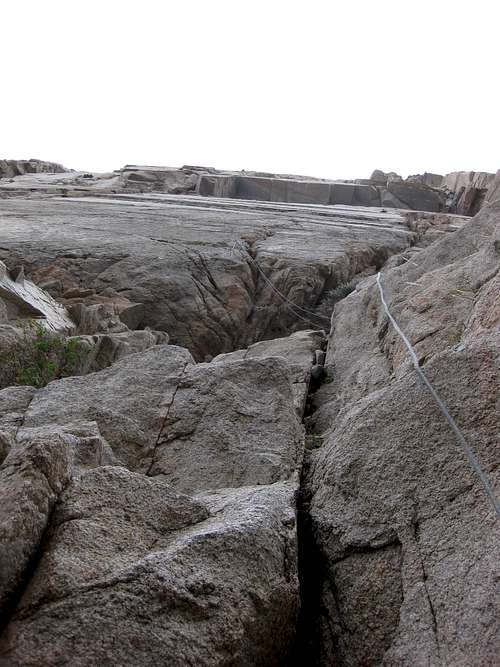
Two to Three more P's possible with the next P looking at .10b/c as well and then the 3rd P through the roofs at a possible .11a.
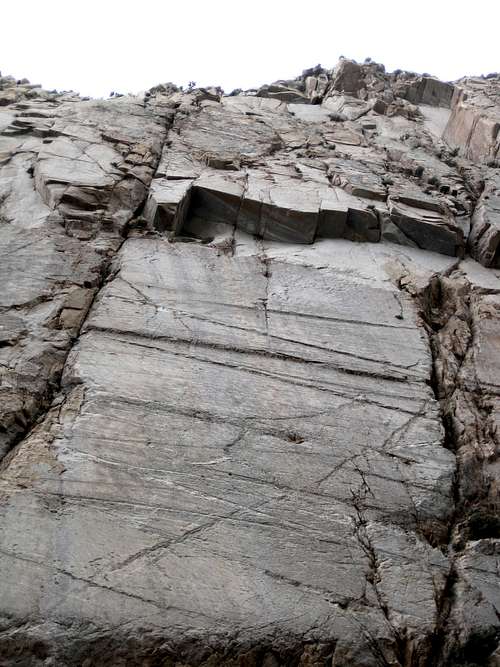
Can't wait to return this Spring with my buddy Derek and see what in fact the VAR's will be for the following P's...
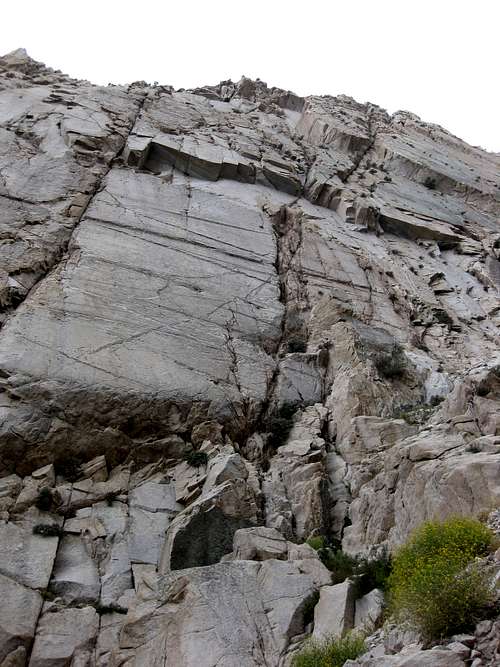

Two to Three more P's possible with the next P looking at .10b/c as well and then the 3rd P through the roofs at a possible .11a.

Can't wait to return this Spring with my buddy Derek and see what in fact the VAR's will be for the following P's...

-

Ze - Posts: 336
- Joined: Tue Oct 21, 2008 2:50 am
- Thanked: 61 times in 33 posts
by Ze » Sat Feb 27, 2010 5:51 pm
Day Hiker wrote:I have only climbed San Antonio in winter via the Baldy Bowl, so I haven't been on the entire trail, but it's my understanding that the trail is only about 4 miles, not 8. Of course the elevation gain is the same either way, at around 3900 feet.
So, assuming a constant grade for simplicity, with a hypotenuse of 4 miles and a gain of 3900 feet, the trail's average grade is about 18.8%.
How about 5 times in one day? http://www.rickkent.net/ViewerPlus/viewer.aspx?FolderID=820
Check out the impressive times, even on the 5th ascent, from mile 32 to mile 40: http://www.rickkent.net/ViewerPlus/viewtextfile.aspx?ID=114587
To have only a 10% grade, the trail would have to be about 7.4 miles long, but it's not. Or were you just talking about the bottom mile of the trail? Or is the "Baldy Race" on an entirely different trail?
Yeah, The Baldy Race continues up the fireroad (does not veer off to Ski Hut trail) to Baldy Notch, then heads up Devil's Backbone to the summit.
Yeah Rick is quite a masochist. I think Baldy 5x is more impressive than Skyline 3x. Of course now he has to go back and hike Iron again because I tied his best time (without running
-

MoapaPk - Posts: 7780
- Joined: Fri May 13, 2005 7:42 pm
- Thanked: 787 times in 519 posts
by MoapaPk » Sat Feb 27, 2010 6:12 pm
Some people define the grade of a slope as the 100%*tangent; others as the 100%*sine. From DayHiker's mention of hypotenuse, I'm guessing that he is using the latter definition. Not too much difference when the angle is small, but a lot of difference when the angle goes to pi/2. Ze's question "...when the grade gets close to 100%, and you're scrambling up?" suggests that he is using the tan approach, as 100% in the sine definition is a vertical wall.
http://en.wikipedia.org/wiki/Grade_%28slope%29
http://en.wikipedia.org/wiki/Grade_%28slope%29
-

Day Hiker - Posts: 3156
- Joined: Fri Dec 26, 2003 2:57 am
- Thanked: 61 times in 43 posts
by Day Hiker » Sat Feb 27, 2010 8:41 pm
MoapaPk wrote:Some people define the grade of a slope as the 100%*tangent; others as the 100%*sine. From DayHiker's mention of hypotenuse, I'm guessing that he is using the latter definition. Not too much difference when the angle is small, but a lot of difference when the angle goes to pi/2. Ze's question "...when the grade gets close to 100%, and you're scrambling up?" suggests that he is using the tan approach, as 100% in the sine definition is a vertical wall.
http://en.wikipedia.org/wiki/Grade_%28slope%29
No!!!!
Grade is defined as rise over run -- the tangent of the incline angle, NOT the sine. And the tangent is what I am using!
I mention hypotenuse because we were talking about trail distance, and that is the hypotenuse, not the horizontal distance. A hiker's feet and legs have no direct perception of the horizontal distance; a hiker travels the actual trail distance, and that, along with the elevation gain, is what is perceived by the hiker. For an analysis of the statistics of a hike, the actual horizontal distance traveled is quite meaningless in itself.
Check out the highlighted text:
Day Hiker wrote:I have only climbed San Antonio in winter via the Baldy Bowl, so I haven't been on the entire trail, but it's my understanding that the trail is only about 4 miles, not 8. Of course the elevation gain is the same either way, at around 3900 feet.
So, assuming a constant grade for simplicity, with a hypotenuse of 4 miles and a gain of 3900 feet, the trail's average grade is about 18.8%.
. . .
[With 3900 feet of gain,] to have only a 10% grade, the trail would have to be about 7.4 miles long, but it's not.
. . .
If you check those numbers, you will see that I am defining grade as the tangent of the incline angle, not the sine.
For the first case, if I were using the sine, the calculation of 3900 feet divided by 4 trail (hypotenuse) miles would yield around 18.5% which is not the number I posted.
For the second case, it's not so obvious because either definition would yield 7.4 miles, if rounded to the first decimal place. To four places, the correct value, defining grade as the tangent, is 7.4232 miles, which is how I did my calculation. Using the incorrect sine definition for the calculation would yield 7.3864 miles (39000 feet).
-

kevin trieu - Posts: 979
- Joined: Mon Mar 21, 2005 5:59 pm
- Thanked: 88 times in 64 posts
by kevin trieu » Sat Feb 27, 2010 8:55 pm
boy, way too much science. what happened to heading outside for a walk in the woods without worrying about how far, how fast, how efficient... 
-

MoapaPk - Posts: 7780
- Joined: Fri May 13, 2005 7:42 pm
- Thanked: 787 times in 519 posts
by MoapaPk » Sat Feb 27, 2010 9:05 pm
Day Hiker wrote:MoapaPk wrote:Not too much difference when the angle is small, but a lot of difference when the angle goes to pi/2.
So, assuming a constant grade for simplicity, with a hypotenuse of 4 miles and a gain of 3900 feet, the trail's average grade is about 18.8%.
If you check those numbers, you will see that I am defining grade as the tangent of the incline angle, not the sine.
Hmmmm, 18.8 vs 18.5%. When I see a number given to 1 digit of precision (4 miles), I don't figure the accuracy of measurement warrants distinction between 18.5 and 18.8, eh?
Which I guess supports the bolded point -- there isn't much difference for lower angles.
Which is why I'd like clarification on Ze's definition -- before I show plots for tan ~ 1.
EDIT: Chief already gave examples for tan -> infinity.
-

Day Hiker - Posts: 3156
- Joined: Fri Dec 26, 2003 2:57 am
- Thanked: 61 times in 43 posts
by Day Hiker » Sat Feb 27, 2010 9:09 pm
MoapaPk wrote:Day Hiker wrote:MoapaPk wrote:Not too much difference when the angle is small, but a lot of difference when the angle goes to pi/2.
So, assuming a constant grade for simplicity, with a hypotenuse of 4 miles and a gain of 3900 feet, the trail's average grade is about 18.8%.
If you check those numbers, you will see that I am defining grade as the tangent of the incline angle, not the sine.
Hmmmm, 18.8 vs 18.5%. When I see a number given to 1 digit of precision (4 miles), I don't figure the accuracy of measurement warrants distinction between 18.5 and 18.8, eh?
My point is NOT that there is a big difference between 18.8 and 18.5. My point is that you could determine for yourself that I was in fact using the correct definition (tangent) for the calculations. You had stated that you guessed I was using the wrong method:
MoapaPk wrote:Some people define the grade of a slope as the 100%*tangent; others as the 100%*sine. From DayHiker's mention of hypotenuse, I'm guessing that he is using the latter definition.
-
- Related topics
- Replies
- Views
- Last post
-
- Vertical Limit Guide to Climbing
1, 2by jordansahls » Tue Nov 17, 2009 9:46 pm - 15 Replies
- 6444 Views
- Last post by Brad F

Wed Dec 23, 2009 1:27 am
- Vertical Limit Guide to Climbing
-
- Ascent and descent on a rope
by riverman » Tue May 24, 2011 10:54 am - 1 Replies
- 2465 Views
- Last post by Hotoven

Wed May 25, 2011 10:55 pm
- Ascent and descent on a rope
-
- El Cap-disabled ascent
by Vitaliy M. » Wed Oct 24, 2012 10:42 pm - 5 Replies
- 4217 Views
- Last post by TimB

Thu Oct 25, 2012 4:57 pm
- El Cap-disabled ascent
Who is online
Users browsing this forum: No registered users and 0 guests
You need to login in order to vote!
Don't have an account?
- Rating available
- Suggested routes for you
- People who climb the same things as you
- Comments Available
- Create Albums


